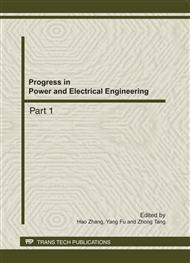[1]
J.Hughes, IntelliGrid architecture concepts and IEC 61850, Proceedings of IEEE PES Transmission and Distribution Conference and Exhibition. May 21-24, 2006, Dallas, TX, USA.
Google Scholar
[2]
S. Rahman, M. Pipattanasomporn, and Y.Teklu, Intelligent distributed autonomous power systems (IDAPS), Proceedings of IEEE Power Engineering Society General Meeting. June 24-26, 2007, Tampa, FL, USA.
DOI: 10.1109/pes.2007.386043
Google Scholar
[3]
M.Amin, Toward a self-healing energy infrastructure, Proceedings of IEEE Power Engineering Society General Meeting. June 18-22, 2006, Montreal, Canada.
DOI: 10.1109/pes.2006.1709607
Google Scholar
[4]
K. Moslehi, A. B. R. Kumar, D. shurtleff, et al, Framework for a self-healing power grid, Proceedings of IEEE Power Engineering Society General Meeting. June 12-16, 2005, Montreal, Canada.
DOI: 10.1109/pes.2005.1489709
Google Scholar
[5]
Nima Amjady, Farshid Keynia, and Hamidreza Zareipour, Short-term load forecast of microgrids by a new Bilevel prediction strategy, IEEE Transactions on Power Systems, December 2010, 1(3) : 286-294.
DOI: 10.1109/tsg.2010.2078842
Google Scholar
[6]
V.H. Hinojosa, A.Hoese, Short-term load forecasting using fuzzy inductive reasoning and evolutionary algorithms, IEEE Transactions on power systems, February 2010, 25(1) 565-574.
DOI: 10.1109/tpwrs.2009.2036821
Google Scholar
[7]
H.M.Al-Hamadi, S.A. Soliman, Fuzzy short-term electric load forecasting using Kalman filter, IEE Generation, Transmission and Distribution, Vol.153, No.2, March 2006, 217-227.
DOI: 10.1049/ip-gtd:20050088
Google Scholar
[8]
M.A. Abu-El-Magd, and R.D. Findlay, A new approach using artificial neural network and time series models for short term load forecasting, CCGEI 2003. May 2003, Montreal, Canada, 1723-1726.
DOI: 10.1109/ccece.2003.1226242
Google Scholar
[9]
T.Senjyu, S.Higa, and K.Uezato, Future load curve shaping based on similarity using fuzzy logic approach, IEE Generation, Transmission and Distribution. Vol.145, No.4, July 1998, 375-380.
DOI: 10.1049/ip-gtd:19981998
Google Scholar
[10]
Nasser Sadati, Guy A.Dumont, and H.R. Feyz Mahdvian, Robust multiple model adaptive control using fuzzy fusion, 42nd South Eastern Symposium on System Theory University of Taxas Tyler. Tyler, TX, March 7-9, (2010)
DOI: 10.1109/ssst.2010.5442796
Google Scholar


